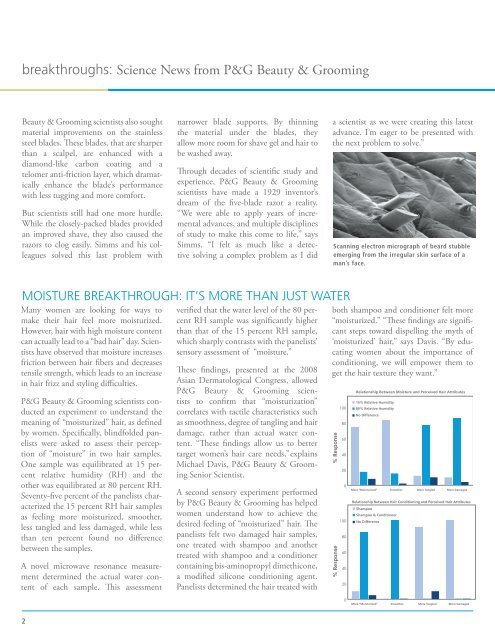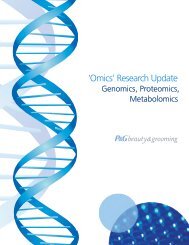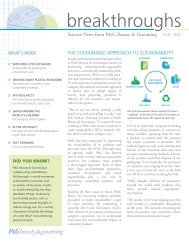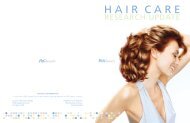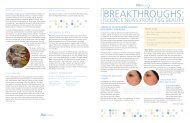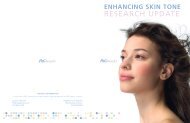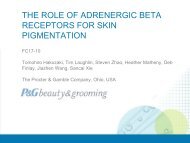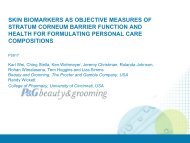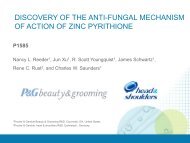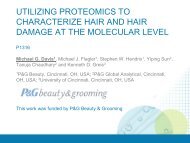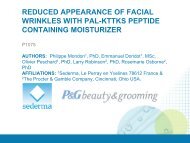breakthroughs - P&G Beauty & Grooming | Error Page
breakthroughs - P&G Beauty & Grooming | Error Page
breakthroughs - P&G Beauty & Grooming | Error Page
You also want an ePaper? Increase the reach of your titles
YUMPU automatically turns print PDFs into web optimized ePapers that Google loves.
eakthroughs: Science News from P&G <strong>Beauty</strong> & <strong>Grooming</strong><br />
<strong>Beauty</strong> & <strong>Grooming</strong> scientists also sought<br />
material improvements on the stainless<br />
steel blades. These blades, that are sharper<br />
than a scalpel, are enhanced with a<br />
diamond-like carbon coating and a<br />
telomer anti-friction layer, which dramatically<br />
enhance the blade’s performance<br />
with less tugging and more comfort.<br />
But scientists still had one more hurdle.<br />
While the closely-packed blades provided<br />
an improved shave, they also caused the<br />
razors to clog easily. Simms and his colleagues<br />
solved this last problem with<br />
narrower blade supports. By thinning<br />
the material under the blades, they<br />
allow more room for shave gel and hair to<br />
be washed away.<br />
Through decades of scientific study and<br />
experience, P&G <strong>Beauty</strong> & <strong>Grooming</strong><br />
scientists have made a 1929 inventor’s<br />
dream of the five-blade razor a reality.<br />
“We were able to apply years of incremental<br />
advances, and multiple disciplines<br />
of study to make this come to life,” says<br />
Simms. “I felt as much like a detective<br />
solving a complex problem as I did<br />
a scientist as we were creating this latest<br />
advance. I’m eager to be presented with<br />
the next problem to solve.”<br />
Scanning electron micrograph of beard stubble<br />
emerging from the irregular skin surface of a<br />
man’s face.<br />
MOISTURE BREAKTHROUGH: IT’S MORE THAN JUST WATER<br />
Many women are looking for ways to<br />
make their hair feel more moisturized.<br />
However, hair with high moisture content<br />
can actually lead to a “bad hair” day. Scientists<br />
have observed that moisture increases<br />
friction between hair fibers and decreases<br />
tensile strength, which leads to an increase<br />
in hair frizz and styling difficulties.<br />
P&G <strong>Beauty</strong> & <strong>Grooming</strong> scientists conducted<br />
an experiment to understand the<br />
meaning of “moisturized” hair, as defined<br />
by women. Specifically, blindfolded panelists<br />
were asked to assess their perception<br />
of “moisture” in two hair samples.<br />
One sample was equilibrated at 15 percent<br />
relative humidity (RH) and the<br />
other was equilibrated at 80 percent RH.<br />
Seventy-five percent of the panelists characterized<br />
the 15 percent RH hair samples<br />
as feeling more moisturized, smoother,<br />
less tangled and less damaged, while less<br />
than ten percent found no difference<br />
between the samples.<br />
A novel microwave resonance measurement<br />
determined the actual water content<br />
of each sample. This assessment<br />
verified that the water level of the 80 percent<br />
RH sample was significantly higher<br />
than that of the 15 percent RH sample,<br />
which sharply contrasts with the panelists’<br />
sensory assessment of “moisture.”<br />
These findings, presented at the 2008<br />
Asian Dermatological Congress, allowed<br />
P&G <strong>Beauty</strong> & <strong>Grooming</strong> scientists<br />
to confirm that “moisturization”<br />
correlates with tactile characteristics such<br />
as smoothness, degree of tangling and hair<br />
damage, rather than actual water content.<br />
“These findings allow us to better<br />
target women’s hair care needs,” explains<br />
Michael Davis, P&G <strong>Beauty</strong> & <strong>Grooming</strong><br />
Senior Scientist.<br />
A second sensory experiment performed<br />
by P&G <strong>Beauty</strong> & <strong>Grooming</strong> has helped<br />
women understand how to achieve the<br />
desired feeling of “moisturized” hair. The<br />
panelists felt two damaged hair samples,<br />
one treated with shampoo and another<br />
treated with shampoo and a conditioner<br />
containing bis-aminopropyl dimethicone,<br />
a modified silicone conditioning agent.<br />
Panelists determined the hair treated with<br />
both shampoo and conditioner felt more<br />
“moisturized.” “These findings are significant<br />
steps toward dispelling the myth of<br />
‘moisturized’ hair,” says Davis. “By educating<br />
women about the importance of<br />
conditioning, we will empower them to<br />
get the hair texture they want.”<br />
% Response<br />
% Response<br />
100<br />
80<br />
60<br />
40<br />
20<br />
0<br />
100<br />
80<br />
60<br />
40<br />
20<br />
Relationship Between Moisture and Perceived Hair Attributes<br />
15% Relative Humidity<br />
80% Relative Humidity<br />
No Difference<br />
More “Moisturized”<br />
Smoother More Tangled More Damaged<br />
Relationship Between Hair Conditioning and Perceived Hair Attributes<br />
Shampoo<br />
Shampoo & Conditioner<br />
No Difference<br />
0<br />
More “Moisturized”<br />
Smoother More Tangled More Damaged<br />
2


